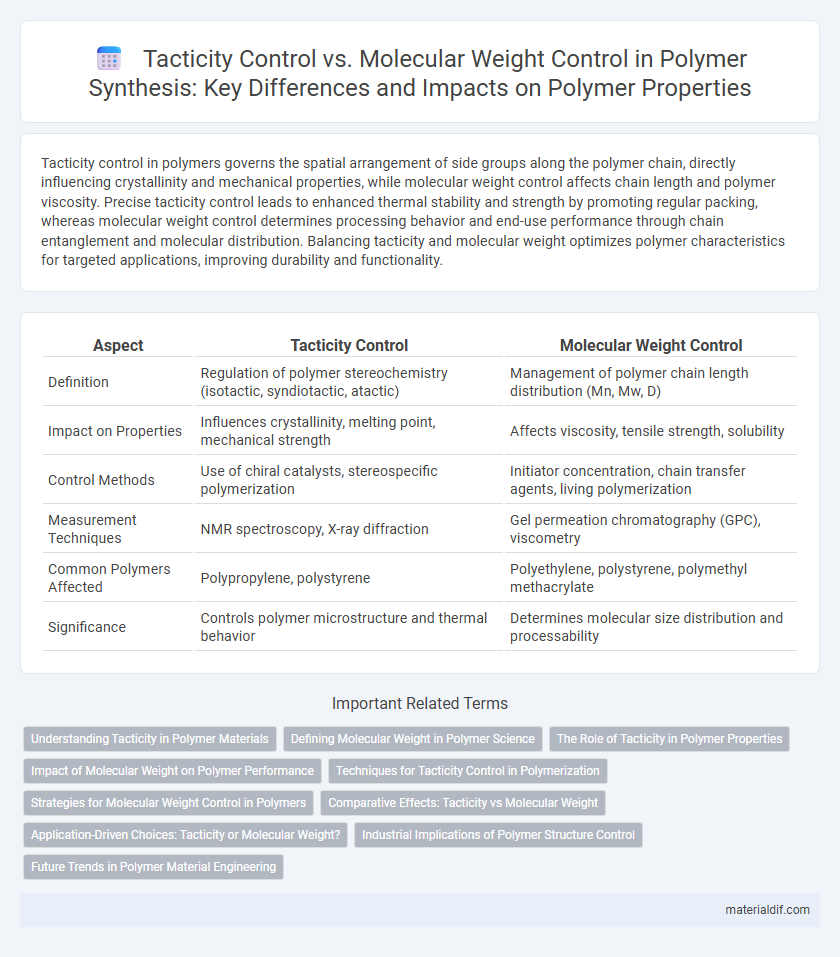Tacticity control in polymers governs the spatial arrangement of side groups along the polymer chain, directly influencing crystallinity and mechanical properties, while molecular weight control affects chain length and polymer viscosity. Precise tacticity control leads to enhanced thermal stability and strength by promoting regular packing, whereas molecular weight control determines processing behavior and end-use performance through chain entanglement and molecular distribution. Balancing tacticity and molecular weight optimizes polymer characteristics for targeted applications, improving durability and functionality.
Table of Comparison
| Aspect | Tacticity Control | Molecular Weight Control |
|---|---|---|
| Definition | Regulation of polymer stereochemistry (isotactic, syndiotactic, atactic) | Management of polymer chain length distribution (Mn, Mw, D) |
| Impact on Properties | Influences crystallinity, melting point, mechanical strength | Affects viscosity, tensile strength, solubility |
| Control Methods | Use of chiral catalysts, stereospecific polymerization | Initiator concentration, chain transfer agents, living polymerization |
| Measurement Techniques | NMR spectroscopy, X-ray diffraction | Gel permeation chromatography (GPC), viscometry |
| Common Polymers Affected | Polypropylene, polystyrene | Polyethylene, polystyrene, polymethyl methacrylate |
| Significance | Controls polymer microstructure and thermal behavior | Determines molecular size distribution and processability |
Understanding Tacticity in Polymer Materials
Tacticity control in polymer materials directly influences the arrangement of polymer chains, significantly affecting properties such as crystallinity, melting temperature, and mechanical strength. Unlike molecular weight control, which primarily dictates chain length and impacts viscosity and tensile properties, tacticity defines the stereoregularity of polymer chains, enabling precise tuning of material performance at the molecular level. Understanding tacticity in polymers like polypropylene and polystyrene is crucial for designing materials with targeted thermal stability and processability.
Defining Molecular Weight in Polymer Science
Molecular weight in polymer science refers to the mass of a polymer molecule, typically expressed as the average molecular weight of all chains in a sample, which directly influences physical properties such as tensile strength and melting temperature. Tacticity control, describing the stereochemical arrangement of polymer chains, impacts crystallinity and mechanical behavior but does not define molecular weight. Precisely measuring molecular weight using techniques like gel permeation chromatography (GPC) is crucial for tailoring polymer performance and processing characteristics.
The Role of Tacticity in Polymer Properties
Tacticity significantly influences polymer crystallinity, melting temperature, and mechanical strength by determining the spatial arrangement of side groups along the polymer chain. Controlled tacticity enhances polymer stiffness and chemical resistance, whereas molecular weight primarily affects viscosity and tensile strength. Optimizing tacticity during synthesis tailors polymer properties for applications requiring precise thermal and structural performance.
Impact of Molecular Weight on Polymer Performance
Molecular weight directly influences polymer performance by affecting mechanical strength, toughness, and thermal stability, with higher molecular weights generally enhancing these properties due to increased chain entanglements. Tacticity control governs stereoregularity, impacting crystallinity and melting temperature, which are critical for processing and end-use applications. Balancing molecular weight and tacticity is essential for tailoring polymers with optimized mechanical and thermal characteristics for specific performance requirements.
Techniques for Tacticity Control in Polymerization
Tacticity control in polymerization is primarily achieved through stereospecific catalysts such as Ziegler-Natta and metallocene catalysts, which influence the spatial arrangement of monomer units along the polymer chain. These catalysts enable precise control over isotactic, syndiotactic, or atactic configurations by selectively coordinating the monomer insertion during chain propagation. Unlike molecular weight control, which relies on parameters such as initiator concentration and chain transfer agents, tacticity control is fundamentally governed by catalyst design and polymerization conditions.
Strategies for Molecular Weight Control in Polymers
Strategies for molecular weight control in polymers primarily involve regulating polymerization conditions such as monomer concentration, initiator type, and reaction temperature to achieve desired chain length and distribution. Techniques like living polymerization, including anionic, cationic, and controlled radical polymerization methods, enable precise tuning of molecular weight by minimizing chain termination and transfer reactions. Molecular weight control directly influences polymer properties like mechanical strength, thermal stability, and processability, making it essential for designing materials with specific performance criteria.
Comparative Effects: Tacticity vs Molecular Weight
Tacticity control directly influences polymer crystallinity and mechanical strength, affecting properties like melting temperature and stiffness, while molecular weight control primarily impacts viscosity, tensile strength, and elongation at break. High tacticity often leads to enhanced polymer packing and thermal resistance, whereas increased molecular weight improves toughness and processability by extending chain entanglements. Balancing tacticity and molecular weight allows precise tuning of polymer performance for applications ranging from flexible films to rigid structural components.
Application-Driven Choices: Tacticity or Molecular Weight?
Application-driven polymer design prioritizes tacticity control when specific mechanical properties, such as crystallinity and stiffness, are essential, often seen in packaging and biomedical devices. Molecular weight control becomes crucial for applications requiring precise flow behavior and processing characteristics, like fibers and adhesives. Selecting between tacticity or molecular weight depends on target application demands for strength, flexibility, and thermal resistance.
Industrial Implications of Polymer Structure Control
Tacticity control in polymers directly influences crystallinity, melting temperature, and mechanical strength, critical for applications requiring specific thermal and structural properties. Molecular weight control impacts polymer viscosity, processability, and tensile strength, affecting manufacturing efficiency and end-product performance. Industrial polymer production optimizes both tacticity and molecular weight to tailor materials for sectors such as automotive, packaging, and biomedical devices, enhancing product durability and functionality.
Future Trends in Polymer Material Engineering
Tacticity control in polymer synthesis enhances crystallinity and thermal properties, enabling the design of materials with precise mechanical performance for advanced applications. Molecular weight control influences polymer chain length and distribution, directly impacting viscosity, processability, and durability in end-use products. Future trends in polymer material engineering prioritize integrated strategies combining tacticity and molecular weight control to achieve multifunctional polymers with tailored properties for sustainable and high-performance technologies.
Tacticity Control vs Molecular Weight Control Infographic

 materialdif.com
materialdif.com